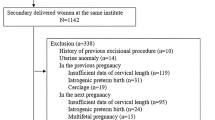Abstract
Background
Preterm delivery is one of the most serious public health problems and is the most important factor relating to neonatal morbidity and mortality. The strategies for preventing it include understanding the risk factors, with specific interventions. Recently, uterine cervix measurements using ultrasonography and vaginal administration of progesterone have gained importance in predicting and secondarily preventing spontaneous preterm delivery.
Objective
To describe the short cervix syndrome, including its etiology, diagnosis, and possible therapies.
Methods
Research in ISI, Pubmed, and Scielo database using the words short cervix, preterm delivery, sludge, cervical funneling, cervical gland area, progesterone, cerclage, and pessary.
Results
We found a lot of articles about this topic, including randomized controlled trials. The etiology is multifactorial, being the diagnosis based in a cervix shortening at 20–24 weeks. The history and measurement of cervix length by transvaginal ultrasound have been shown to be effective to select the high risk pregnancies. The progesterone, cervical cerclage, and cervical pessary showed to be effective to reduce the preterm delivery in pregnant women with short cervix.
Conclusion
The successful management of pregnant women presenting a short cervix depends on the understanding that cervical shortening is the final common path for several causes of preterm delivery. The best approach should be individualized to each patient.



Similar content being viewed by others
References
Haram K, Mortensen JH, Wollen AL (2003) Preterm delivery: an overview. Acta Obstet Gynecol Scand 82:687–704
Nicolaides KH (2007) Some thoughts on the true value of ultrasound. Ultrasound Obstet Gynecol 30:671–674
Sinno A, Usta IM, Nassar AH (2009) A short cervical length in pregnancy: management options. Am J Perinatol 26:761–770
Sotiriadis A, Papatheodorou S, Kavvadias A, Makrydimas G (2010) Transvaginal cervical length measurement for prediction of preterm birth in women with threatened preterm labor: a meta-analysis. Ultrasound Obstet Gynecol 35:54–64
Poon LC, Savvas M, Zamblera D, Skyfta E, Nicolaides KH (2012) Large loop excision of transformation zone and cervical length in the prediction of spontaneous preterm delivery. BJOG 119:692–698
Vaisbuch E, Romero R, Erez O, Kusanovic JP, Mazaki-Tovi S, Gotsch F et al (2010) Clinical significance of early (< 20 weeks) vs. late (20–24 weeks) detection of sonographic short cervix in asymptomatic women in the mid-trimester. Ultrasound Obstet Gynecol 36:471–481
Mancuso MS, Szychowski JM, Owen J, Hankins G, Iams JD, Sheffield JS et al. (2010) Cervical funneling: effect on gestational length and ultrasound-indicated cerclage in high-risk women. Am J Obstet Gynecol 203:259.e1–259.e5
Petit E, Abergel A, Dedet B, Subtil D (2012) The role of infection in preterm birth (article in French). J Gynecol Obstet Biol Reprod (Paris) 41:14–25
To MS, Skentou C, Chan C, Zagaliki A, Nicolaides KH (2001) Cervical assessment at the routine 23-week scan: standardizing techniques. Ultrasound Obstet Gynecol 17:217–219
Campbell S (2011) Universal cervical-length screening and vaginal progesterone prevents early preterm births, reduces neonatal morbidity and is cost saving: doing nothing is no longer an option. Ultrasound Obstet Gynecol 38:1–9
Crane JM, Hutchens D (2011) Transvaginal ultrasonographic measurement of cervical length in asymptomatic high-risk women with a short cervical length in the previous pregnancy. Ultrasound Obstet Gynecol 38:38–43
Fonseca EB, Celik E, Parra M, Singh M, Nicolaides KH; Fetal Medicine Foundation Second Trimester Screening Group (2007) Progesterone and the risk of preterm among women with a short cervix. N Engl J Med 357:462–469
Yamasaki AA, Bittar RE, Fonseca ESB, Martinelli S, Sasaki S, Zugaib M (1998) Prevention of preterm birth: use of digital examination and transvaginal ultrasonography (article in Portuguese). Rev Bras Ginecol Obstet 20:350–356
Keelan J, Marvin K, Sato T, Coleman M, McCowan L, Mitchell M (1999) Cytokine abundance in placental tissues: evidence of inflammatory activation in gestational membranes with term and preterm parturition. Am J Obstet Gynecol 181:1530–1536
Kumar D, Fung W, Moore RM, Pandey V, Fox J, Stetzer B et al (2006) Proinflammatory cytokines found in amniotic fluid induce cervical remodeling, apoptosis, and biophysical weakening of cultured human fetal membranes. Biol Reprod 74:29–34
Keeler SM, Kiefer DG, Rust OA, Vintzileos A, Atlas RO, Bornstein E et al. (2009) Comprehensive amniotic fluid cytokine profile evaluation in women with a short cervix: which cytokine(s) correlates best with outcome? Am J Obstet Gynecol 201:276.e1–276.e6
Kiefer DG, Keeler SM, Rust O, Chow SS, Craig ME, Peltier MR et al. (2012) Amniotic fluid inflammatory score is associated with pregnancy outcome in patients with mid trimester short cervix. Am J Obstet Gynecol 206:68.e1–68.e6
Peaceman AM, Andrews WW, Thorp JM (1997) Fetal fibronectin as a predictor of preterm birth in patients with symptoms: a multicenter trial. Am J Obstet Gynecol 177:13–18
Yoneda S, Sakai M, Sasaki Y, Shiozaki A, Hidaka T, Saito S (2007) Interleukin-8 and glucose in amniotic fluid, fetal fibronectin in vaginal secretions and preterm labor index based on clinical variables are optimal markers for preterm delivery in patients with intact membranes. J Obstet Gynaecol Res 33:38–44
Honest H, Forbes CA, Durée KH, Norman G, Duffy SB, Tsourapas A et al (2009) Screening to prevent spontaneous preterm birth: systematic reviews of accuracy and effectiveness literature with economic modelling. Health Technol Assess 13:1–627
Cicero S, Skentou C, Souka A, To MS, Nicolaides KH (2001) Cervical length at 22–24 weeks of gestation: comparison of transvaginal and transperineal-translabial ultrasonography. Ultrasound Obstet Gynecol 17:335–340
Andersen HF, Nugent CE, Wanty SD, Hayashi RH (1990) Prediction of risk for preterm delivery by ultrasonographic measurement of cervical length. Am J Obstetr Gynecol 163:859–867
Hassan SS, Romero R, Vidyadhari D, Fusey S, Baxter JK, Khandelwal M et al (2011) Vaginal progesterone reduces the rate of preterm birth in women with a sonographic short cervix: a multicenter, randomized, double-blind, placebo-controlled trial. Ultrasound Obstet Gynecol 38:18–31
To MS, Skentou CA, Royston P, Yu CK, Nicolaides KH (2006) Prediction of patient-specific risk of early preterm delivery using maternal history and sonographic measurement of cervical length: a population-based prospective study. Ultrasound Obstet Gynecol 27:362–367
O’Brien JM, Defranco EA, Adair CD, Lewis DF, Hall DR, How H et al (2009) Effect of progesterone on cervical shortening in women at risk for preterm birth: secondary analysis from a multinational, randomized, double-blind, placebo-controlled trial. Ultrasound Obstet Gynecol 34:653–659
Owen J, Iams JD, Hauth JC (2003) Vaginal sonography and cervical incompetence. Am J Obstet Gynecol 188:586–596
Sekiya T, Ishihara K, Yoshimatsu K, Fukami T, Kikuchi S, Araki T (1998) Detection rate of the cervical gland area during pregnancy by transvaginal sonography in the assessment of cervical maturation. Ultrasound Obstet Gynecol 12:328–333
Yoshimatsu K, Sekiya T, Ishihara K, Fukami T, Otabe T, Araki T (2002) Detection of cervical gland area in threatened preterm labor using transvaginal sonography in the assessment of cervical maturation and the outcome of pregnancy. Gynecol Obstet Invest 53:149–156
Fukami T, Ishihara K, Sekiya T, Araki T (2003) Is transvaginal ultrasonography at mid-trimester useful for predicting early spontaneous preterm birth? J Nippon Med Sch 70:135–140
Pires CR, Moron AF, Mattar RM, Kulay Junior L (2004) Assessment of cervix length and absent of echo-glandular endocervical to predict preterm delivery (article in Portuguese). Rev Bras Ginecol Obstet 26:193–200
Pires CR, Moron AF, Mattar R, Diniz AL, Andrade SG, Bussamra LC (2006) Cervical gland area as an ultrasonographic marker for preterm delivery. Int J Gynaecol Obstet 93:214–219
Espinoza J, Gonçalves LF, Romero R, Nien JK, Stites S, Kim YM et al (2005) The prevalence and clinical significance of amniotic fluid ‘sludge’ in patients with preterm labor and intact membranes. Ultrasound Obstet Gynecol 25:346–352
Kusanovic JP, Espinoza J, Romero R, Gonçalves LF, Nien JK, Soto E et al (2007) Clinical significance of the presence of amniotic fluid “sludge” in asymptomatic patients at high risk for spontaneous preterm delivery. Ultrasound Obstet Gynecol 30:706–714
Himaya E, Rhalmi N, Girard M, Tétu A, Desgagné J, Abdous B et al (2011) Midtrimester intra-amniotic sludge and the risk of spontaneous preterm birth. Am J Perinatol 28:815–820
Fox NS, Jean-Pierre C, Predanic M, Chasen ST (2007) Does hospitalization prevent preterm delivery in the patient with a short cervix? Am J Perinatol 24:49–53
van Os MA, van der Ven JA, Kleinrouweler CE, Pajkrt E, de Miranda E, van Wassenaer A et al (2011) Preventing preterm birth with progesterone: costs and effects of screening low risk women with a singleton pregnancy for short cervical length, the Triple P study. BMC Pregnancy Childbirth 11:77
Romero R, Nicolaides K, Conde-Agudelo A, Tabor A, O’Brien JM, Cetingoz E et al. (2012) Vaginal progesterone in women with an asymptomatic sonographic short cervix in the midtrimester decreases preterm delivery and neonatal morbidity: a systematic review and metaanalysis of individual patient data. Am J Obstet Gynecol 206:124.e1–124.e19
Berghella V, Keeler SM, To MS, Althuisius SM, Rust OA (2010) Effectiveness of cerclage according to severity of cervical length shortening: a meta-analysis. Ultrasound Obstet Gynecol 35:468–473
Berghella V, Rafael TJ, Szychowski JM, Rust OA, Owen J (2011) Cerclage for short cervix on ultrasonography in women with singleton gestations and previous preterm birth: a meta-analysis. Obstet Gynecol 117:663–671
Simcox R, Shennan A (2012) Reinforcing cerclage in the prevention of preterm birth in women at high risk: a retrospective case-controlled study. Aust N Z J Obstet Gynaecol 52:224–228
Arabin B, Halbesma JR, Vork F, Hubener M, van Eyck J (2003) Is treatment with vaginal pessaries an option in patients with a sonographically detected short cervix? J Perinat Med 31:122–133
Sieroszewski P, Jasiński A, Perenc M, Banach R, Oszukowski P (2009) The Arabin pessary for the treatment of threatened mid-trimester miscarriage or premature labour and miscarriage: a case series. J Matern Fetal Neonatal Med 22:469–472
Goya M, Pratcorona L, Merced C, Rodó C, Valle L, Romero A et al (2012) Cervical pessary in pregnant women with a short cervix (PECEP): an open-label randomised controlled trial. Lancet 379:1800–1806
Yoshizato T, Inoue Y, Fukami T, Sanui A, Miyamato S, Kawarabayashi T (2010) Longitudinal changes in canal length at 16–35 weeks in normal twin pregnancies and twin pregnancies with preterm labor and delivery. J Obstet Gynaecol Res 4:733–738
Conde-Agudelo A, Romero R (2010) Cervicovaginal fetal fibronectin for the prediction of spontaneous preterm birth in multiple pregnancies: a systematic review and meta-analysis. J Matern Fetal Neonatal Med 23:1365–1376
Gibson JL, Macar LM, Owen P, Young D, Macauly J, Mackenzie F (2004) Prediction of preterm delivery in twin pregnancy: a prospective, observational study of cervical length and fetal fibronectin testing. Ultrasound Obstet Gynecol 23:561–566
Fox NS, Saltzman DH, Klauser CK, Peress D, Gutierrez CV, Rebarber A (2009) Prediction of spontaneous preterm birth in asymptomatic twin pregnancies with the use of combined fetal fibronectin and cervical length. Am J Obstet Gynecol 201:313.e1–313.e5
Klein K, Rode L, Nicolaides KH, Krampl-Bettelheim E, Tabor A; PREDICT Group (2011) Vaginal micronized progesterone and risk of preterm delivery in high-risk twin pregnancies: secondary analysis of a placebo-controlled randomized trial and meta-analysis. Ultrasound Obstet Gynecol 38:281–287
Durnwald CP, Momirova V, Peaceman AM (2010) Second trimester cervical length and risk of preterm birth in women with twin gestations treated with 17 alpha hydroxyprogesterone caproate. J Matern Fetal Neonatal Med 23:1360–1364
Rode L, Klein K, Nicolaides KH, Krampl-Bettelheim, Tabor A, for the PREDICT Group (2011) Prevention of preterm delivery in twin gestations (PREDICT): a multicenter, randomized, placebo-controlled trial on the effect of vaginal micronized progesterone. Ultrasound Obstet Gynecol 38:272–280
Brubaker SG, Gyamfi C (2012) Prediction and prevention of spontaneous preterm birth in twin gestations. Semin Perinatol 3:190–194
Conflict of interest
None.
Author information
Authors and Affiliations
Corresponding author
Rights and permissions
About this article
Cite this article
Guimarães Filho, H.A., Araujo Júnior, E., Pires, C.R. et al. Short cervix syndrome: current knowledge from etiology to the control. Arch Gynecol Obstet 287, 621–628 (2013). https://doi.org/10.1007/s00404-013-2740-0
Received:
Accepted:
Published:
Issue Date:
DOI: https://doi.org/10.1007/s00404-013-2740-0




